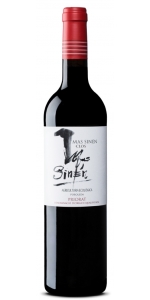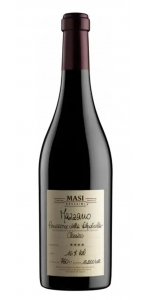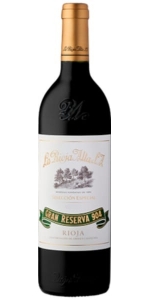Mas Sinen Negre Priorat 2015
3 bottles with free shipping for: $180.00
6 bottles with free shipping for: $330.00
9 bottles with free shipping for: $450.00
| BUY MORE! SAVE MORE! | ||||||||||||||||||||
|
Mas Sinen Negre Priorat is made from 38% Garnacha, 22% Cabernet Sauvignon, 23% Carinena, 16% Syrah
Aged in 90% French, 10% American oak barrels for 12 months.
Maceration for 21 days. ML in stainless steel tanks.
Clarification with white egg and soft filtration.
The wine shows great spice and leather components, some minerality and a lot of ripe red fruits aromas as well.
This wine is certified organic.
Review:
"Dark, bright-rimmed ruby. Highly perfumed, mineral- and smoke-accented red and dark fruit preserve, baking spice and floral pastille aromas, along with hints of licorice and black tea. Gently chewy and focused on the palate, offering juicy cherry, blackberry and spicecake flavors that deepen and turn spicier as the wine opens up. Finishes impressively long and sappy, with a lingering floral nuance, well-integrated tannins and a jolt of smoky minerality. Raised in new and used barrels, 90% French and 10% American.- Josh Raynolds"
- Antonio Galloni's Vinous (March 2021), 93 pts
The Mas Sinen Estate
Mas Sinen is located in the village of Poboleda, in the province of Tarragona. The winery dates back to the 19th century and has been in the family for a few generations. Mas Sinen is a beautiful estate made of stone and surrounded by the family vineyards. Today, Salvador Burgos and his wife Conxita Porta, together with their two daughters, continue the family tradition using the most modern technologies to produce high quality wine from the Priorat Denomination of Origin.
The ancient Mountainous region of Priorat incorporates nine villages of wine production. They are:
- Gratallops
- Bellmunt del Priorat
- Torroja del Priorat
- Poboleda
- Porrera
- La Morera de Montsant
- Escaladei
- La Vilella Alta
- La Vilella Baixa
- El Llorar
- El Molar
The vineyards measure 1.662,55 hectares on size or 4,106.50 acres.
Priorat is about vines per hectare and not about hectares, because the yields are so low.
The name Priorat comes from the word Priory and refers to the 12th century Carthusian Priory established in the region
The old vines in the Priorat region are almost entirely Garnacha and Carignane.
Soil type: local schist called llicorella (decomposing soil type).
Prior to 1979 very few wineries were in production and the area was becoming depopulated. The interest and revolution in Priorat was created by five wineries whose names all began with the word Clos.
1. Clos Mogador - Rene Barber - the modern day pioneer of the region
2. Clos Martinet
3. Clos de L'OBAC
4. Clos Erasmus
5. Clos Dofi - famous winemaker, Rock star and self prom Alvaro Palacios
Today many new small producers with less than 3,000 cases in production are emerging from this area.
Prices for the wines are high and Priorat along with Rioja are the two regions entitled to the highest quality designation by D.O. law: Denominacion de Origen Calificada or DOQ
Today there are 73 wineries in Priorato with new ones coming all the time.
Wines are designed to age for 10-20 years. The styles vary, but Priorat reds are normally dark colored, muscular, tannic, ripe, rich in alcohol in nature Think Chateauneuf-du-Pape from Spain with a Spanish twist.
The Mas Sinen Vineyards
The vineyards measure 15 hectares total. They are planted in terraces, in the slopes of the "Mas Sinen" mountain and are situated 300-500 meters above sea level, cultivated under organic methods. The vines are 5 to 50 years old planted to local schist called llicorella (decomposing soil type) which is typical of the Priorat region.
Siegel Special Reserve Chardonnay is made from 100 percent Chardonnay.
This Chardonnay has a pale yellow color. On the nose is is complex with citrus and tropical fruit aromas balanced with notes from the oak aging. On the palate it has good acidity with a long finish.
VINIFICATION: Alcoholic fermentation occurs at 16-17 degrees C. When the alcoholic finishes part of the wine is kept on a pump-over program.
FINNING AND FILTRATION: Once the wine has been blended it is clarified and then undergoes cold stablisation and is later filtered through clay.
AGING: Aged in French oak barrels for 6 months.
Pairs well with fish like Tilapia, salmon and white meats.
Mas Sinen Clos Priorat is made from 38% Garnacha, 22% Cabernet Sauvignon, 23% Carinena, 16% Syrah.
Before the 2017 vintage, this wine was called Negre. It is the same vinification and level of excellence as the prior cuvee, but with a different name.
It's quite ripe, concentrated, powerful and oaky with black rather than red fruit and peat and graphite aromas. The palate is full-bodied with plenty of rough-hewn tannins and moderate acidity, and is in need of bottle age and/or powerful food. An XXL Priorat.
Mas Sinen Coster Reserve Priorat is made from 50% Grenache and 50% Carignan.
he Priorat DO was created in 1954. But it is only in the 1990 that the quality of the wines were able to compete internationally. It is now a DOCa (The highest qualification level for a wine region according to Spanish wine regulations, alongside Rioja DOCa). Total acreage for the entire appellation is 4,400 acres. Intense red cherry color with garnet reflections. Black fruit, compote fruits, hints of balsamic. The mouth is ripe and intense, fresh and powerful. Strong and flavorful.
50 year old vines planted on Llicorella soil (decomposed black and reddish Slate, mixed with Mica and Quartz). Light filtration.
Mas Sinen La Vall Priorat is made from 57% Garnacha, 24% Cabernet Sauvignon, 10% Cariñena (Carignan), 9% Syrah.
This wine has a highly intense, lively vermilion red color, complex yet direct aromas with predominant ripe black and red fruits, notes of minerals and forest herbs. Flavors are strong, full and layered with round, fresh and delicate tannins.
Pairs with meat, sausage, cheese.
Review:
Fresh violets, lilac, wild plums, allspice and wild herbal aromas pour from the glass. The focused palate shows tart cherry preserves, warmed cloves, roasted coffee and dark chocolate that finishes with a crushed chalk minerality. Fine tannins are present but in balance, working with fresh acidity to keep this wine in harmony. Drink now–2045.
-Wine Enthusiast 97 Points
Mason Cellars Pelissa Vineyard Cabernet Sauvignon is made from 100 percent Cabernet Sauvignon.
The 2020 Mason Oakville Cabernet Sauvignon is quintessentially Oakville from nose to finish. Attractive fresh blackberry, red current and chocolate with a hint of sweet oak boast out of the glass. This wine showcases graphite, velvety tannins and concentrated, beautifully balanced flavors with a bit of spice and white pepper. These bold flavors typical of Oakville Cabernet are rounded out with velvety tannins, a weighty mid-palate and a long, juicy finish.
Production Notes:
The fruit was delicately hand-picked in the early morning hours and brought into the winery for processing. The grapes were crushed, about 60% whole berry, and cold soaked for three days before being inoculated for primary and malo-lactic fermentation. Once dry, the wine was put down to barrel for 20 months in medium toast French oak, 25% of which was new.
Vineyard Notes:
Grapes for our 2020 Mason Cabernet Sauvignon are sourced exclusively from the Pelissa Vineyard in Oakville. This vineyard spans 60 acres and is planted to Old BV Clone 7 Cabernet Sauvignon as well as Zinfandel. This vineyard is named for Andrew and Babe Pelissa, who after their marriage on August 30, 1930, made their home at the site of this vineyard which, at the time, was a dairy. Oakville is the core of Napa Valley’s famed Cabernet Sauvignon production, and this site is no exception with the flawless blending of climate and soil to create a remarkable wine.
Review:
“This firmly structured, well-balanced wine has the feel of a classic Bordeaux blend. Just-ripe red and black fruits blend with subtle toast, cedar and mint on a moderately tannic, slightly tangy texture. The wine is tasty enough to decant and drink soon with grilled lamb chops or roast chicken. Best from 2026–2036.” – Jim Gordon
-Wine Enthusiast 94 Points
La Rioja Alta Gran Reserva 904 is made from 90% Tempranillo, 10% Graciano
The 2015 Gran Reserva 904 Tinto offers great aromatic complexity, with notes of wild strawberry, red cherry, plum, blackberry and cranberry combined with aromas of tobacco, brioche, ground coffee, caramel, cedar and cinnamon blossom. The alcohol and acidity are elegantly balanced on the palate and its polished, gentle tannins and freshness provide a smooth and refined mouthfeel. Fine, delicate and very long aftertaste, that will continue to be rounded with time in the bottle, making this new Gran Reserva 904 a wine with great cellaring potential.
Especially recommended with all kinds of meat and stews, seasoned fish and desserts with chocolate or red fruit toppings. Perfect as an after-dinner drink.
Review:
A perfumed nose of plums, mulberries, mushrooms, caramel, sweet tobacco and sweet spices. Full-bodied with velvety, fine tannins and lively acidity. Balanced and supple with a creamy texture. Delicate and precise with a long, polished finish.
- James Suckling 97 Points
- back
Leindl Gruner Veltliner Seeberg Kamptal is made form 100 percent Gruner Veltiner. Medium yellow green. Fine yellow apple fruit, delicate hint of quince and honey, candied orange zest, highly attractive bouquet. Juicy, good complexity, extract core sweet, silky texture, fine acidity bow, fine and salty minerality, great length, secure aging potential, a very finesse Veltliner-style.
Review:
“Inviting nose, with layers of quince and elegant, aromatic herb leading through to a richly textured palate of opulent fruit and a fine acidity.”
- Decanter World Wine Awards 2023, 96 pts
Clos Saint-Jean is a 41-hectare estate in Châteauneuf-du-Pape run by brothers Vincent and Pascal Maurel. Considered by many critics and wine-writers as the preeminent estate espousing the modern style of winemaking in Châteauneuf, this cellar is one of the oldest in the region, having been founded in 1900 by the greatgreat-grandfather of Vincent and Pascal, Edmund Tacussel. A short time after its founding and well before the AOP of Chateauneuf-du-Pape was created in 1923, Edmund began bottling estate wines in 1910.
The farming at Clos Saint-Jean is fully sustainable due to the warm and dry climate, which prevents the need for chemical inputs. Instead, Vincent and Pascal employ organic methods for pest control, mainly pheromones, to prevent pests from taking up residence in their vines, a process called amusingly enough in French, confusion sexuelle. The vines tended manually, and harvest is conducted in several passes entirely by hand.
Deus ex Machina is a literary and dramatic term for a miraculous intervention that interrupts a logical course of events in a plot or play. A suitable name for a cuvée that had it’s start in the torrid vintage of 2003 when Philippe Cambie and Vincent Maurel made the decision to harvest at the end of September, weeks after their neighbors. Deus ex Machina is a blend of old vine Grenache from La Crau, aged in tank with equally ancient Mourvedre from the sandy soils of BoisDauphin aged in demi-muid. Deus ex Machina is only made in the best vintages.
Review:
Lastly, the 2022 Châteauneuf Du Pape Deus-Ex Machina shows a similar profile to the Combes des Fous, yet it brings another level of tannins and concentration. Kirsch liqueur, white flowers, sandalwood, cured meats, and graphite notes all shine here, and it's full-bodied, has a deep, layered, powerful, yet weightless profile, lots of ripe tannins, and a blockbuster of a finish. This ripe, sexy, seamless, incredibly impressive beauty will compete with anything in the vintage. As usual, this cuvée is 60% Grenache and 40% Mourvedre, which is brought up in roughly 40% new demi-muids.
Review: Jeb Dunnuck 97 Points













